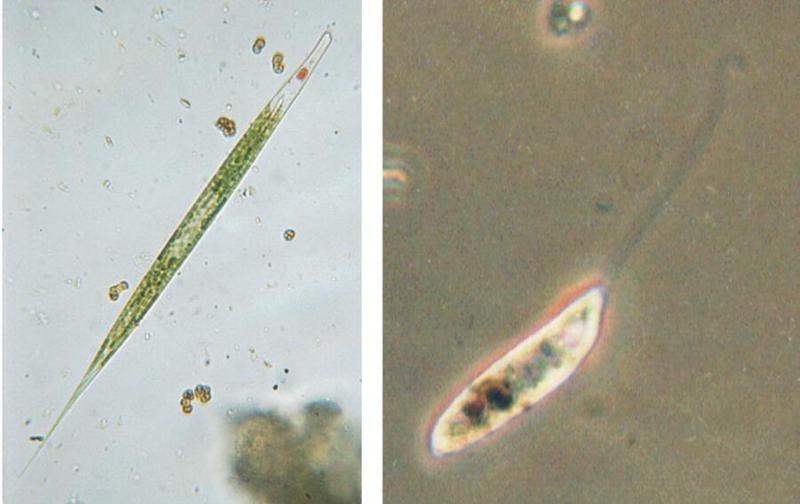|
| Query: Ciliate | Result: 21st of 22 | |
PING MacTrix - Protozoa series - new scans, #4 - Phacus oscillans & friends
| Subject: | PING MacTrix - Protozoa series - new scans, #4 - Phacus oscillans & friends
| | Poster: | Schmode (schmode@vossnet.de)
| |

| File size : 49102 bytes
File date : 2001:02:21 16:31:38
Resolution: 900x567
Jpeg process : Baseline
Posted Newsgroups: alt.binaries.pictures.animals
Posted Date: 17 Aug 1998 15:20:08 -0500 |
PING MacTrix - Protozoa series - new scans, #4 - Phacus oscillans & friends
Hello out there,
sorry, this one, again, is a little bandwidth expensive.
I already showed you an organism called Euglena acus. I said it was a
borderline posting because Euglena has one distinctive feature which is
regarded as typical of a plant - a carbon metabolism based on
photosynthesis using chlorophyll-filled structures within Euglena's
body.
The shot on top now is another organism of the same order. This guy is
called Phacus oscillans; it is, though, often referred to as an Euglena
if being talked about by persons who feel no need to exercise absolute
scientific correctness - such as me.
I have included another shot of Euglena acus on the lower left to allow
comparison. You can see that inrespective of the differences in shape
the anatomy of the organisms is quite similar. Their body is filled with
smaller sub-structures containing chlorophyll; these structures are
called chloroplasts. The most distinctive feature of the Euglena family
is the red eye stain; This primitive eye contains a substance closely
related to carotene which is subject to reversible chemical changes upon
light absorption; it enables the organism to find the light being needed
for photosynthesis.
But to find the light doesn't necessarily mean to get there. When I told
you about Euglena acus I mentioned they have a tool to actively get to
the light; a short filament at the front end with a muscle-like chemical
structure that enables locomotion. That filament which is known as
flagellum was not visible in my Euglena acus posting; it neither is on
the Euglena acus shot on the lower left. Now take a look at the Phacus
oscillans pictured above, find the eye, then look left - there it is. A
tiny, transparent structure which often remains invisible in normal
("brightfield") light microscopy. To make it visible a special way of
illumination was used: If you use brightfield illumination and then
start to move the light source in an excentric position there is a point
when structures of different optical density, that is refraction index,
all of a sudden start to make contrast due to a physical phenomenon
called total reflection. That method was being used here; if the light
source is set accurately the image almost gets a 3-dimensional
appearance with light and shadow zones all over it which often render
structures clearer. I'll show you a shot of a ciliate where that is
somewhat more impressive.
Because of the flagellum being used for locomotion these class of
Protozoa is called flagellates. Not all of them make their existence on
photosynthesis; there are some who make their living on dissolved
substances or even go out hunting. I have included a pic of such guy on
the lower right; this one is called a Peranema. Euglena acus, measuring
about 1/100 of an inch, is about 10 times larger than Peranema. Phacus
oscillans is in-between, roughly half the size of Euglena acus.There are
some stains of green in Peranema's body; they are no chloroplasts but
small algae being in the process of digestion. Being made in phase
contrast illumination this photo clearly shows the size and location of
the flagellum; if it comes to photographing organisms that are
colourless, that have flagella or cilia phase contrast really pays.
By the way, algae with flagella also exist. As they would be definitely
off-topic here I may feel to post one of them in
alt.binaries.pictures.misc or so some time. If that is the case, I'll
tell you about it.
More Protozoa and one more illumination trick waiting for you.
It's midnight here in good old Germany - Good night,
Ralf
name="Oscillans.jpg"
name="flagellates.jpg" |
^o^
Animal Pictures Archive for smart phones
^o^
|
|

